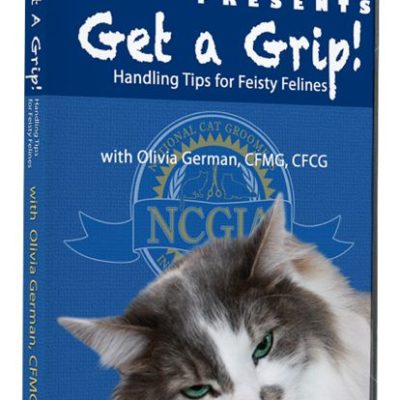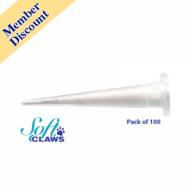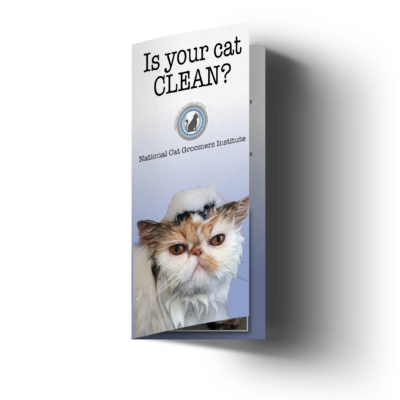In case you’re wondering what I mean when I refer to a “pelt,” let me explain. A pelt is a mass of fused together mats that form over a cat’s body. A pelt can be small, covering only a portion of a cat’s body, such as a hip or the belly. And a pelt can be large, covering nearly every part of a cat, even to up around the face and to the ends of the tail.
I’ve heard other groomers refer to a pelt as a ‘turtle shell’ or a ‘body cast’ before. These terms surely fit, as a pelt by any name is hard, solid, and stuck to the cat. The only way to remove a pelt is by shaving the hair completely off, very close to the skin. As you might imagine, this is very tedious and dangerous work – most cats are not fond of pain or of being handled to the degree required to free a cat from a body cast of matted hair.
But, unfortunately cat groomers must deal with the difficult and dangerous task of pelt removal on a regular basis.
Why? Hmmm….yes, why?
And here we are right back to my initial questions at the start of The Grossness Series.
So in an effort to eradicate this problem, let me explain how a cat ends up pelted:
- Cats are greasy.
- Cats shed (pretty much all the time)
- Greasy shedding hair sticks to greasy hair still attached to the cat, forming a tangle.
- Tangles grow up to be mats.
- Mats fuse together to become a pelt.
If this is true (which it is) then wouldn’t it then make sense to attack facts 1 and 2 right when they start? I think so. I know so. I guarantee to my clients so.
HERE IT IS, INA NUTSHELL. TAKE NOTE: If a proper and thorough degreasing bath is given on a regular basis AND a cat’s properly and thoroughly degreased, squeaky clean coat is properly and thoroughly dried with an appropriate drier and then properly and thoroughly combed out to the point of “glide,” then facts 1 and 2 never lead to 3-5.
(if you are confused by this, no matter. That’s what Certified Feline Master Groomers are for! They know what this means and how to do it!)
The greasy-sheddy stuff is gone. Eliminated just when it starts to rear its ugly head. Stopped in its tracks! No more 3 through 5. No more pelts.
This is so completely, utterly, and entirely possible. It’s just that easy.
This photo shows the transition that occurs in fact 4 listed above. Tangles growing up to be mats. Our HV dryer exposes this so clearly. This particular cat is on the verge of having its mats fuse together to become a pelt. Not quite, but almost. And at this point, the mats are pulling on the skin, causing sores and other painful consequences such as not being able to move the legs freely. No wonder cats tend to be cranky. I’d be cranky too if I was all wrapped up in knots that pulled at my skin and left me unable to walk about freely,
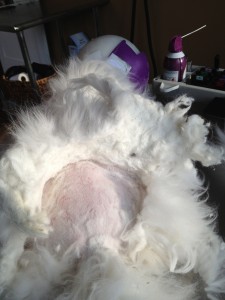
Here is pelt removal in progress. Note how thick the encasement is. The cat’s skin has not been touched for many months while this lovely pelt was forming over its body. Often we find all kinds of wonderful goodies underneath: thousands of fleas that are eating a cat alive (literally), open sores, infections, prickly outdoor debris, and more. It’s almost like a treasure hunt!
Pelt removal at my salon costs a pretty chunk of change. It requires a great deal of time (groomers are in the service industry and thus paid for their time), it puts unnecessary wear and tear on my grooming equipment (dulls those expensive clipper blades!), and it’s downright dangerous!
(My hands are my livelihood. If a cat causes damage to my hands- permanent or otherwise – I am out of work. This is why MOST groomers opt not to groom cats. There is way too much risk involved. If you find a skilled and knowledgeable expert cat groomer who is WILLING to take on your pelted angry kitty, then consider yourself very, very lucky!)
If you are thinking of saving yourself a bit of money and doing some at-home grooming, think again! Here’s a photo showing a cat’s skin cut wide open by a frugal do-it-yourselfer with a sharp pair of scissors. So much for frugality. This turned into a hefty vet bill in addition to a professional groom. And a scar for the cat – a forever souvenir of the occasion.
If you want a keepsake to remember how much you loved your cat, ask to have the pelt after it is removed from your cat’s body. A stinky pelt with flecks of dandruff and dried nuggets of poop is definitely more fun to show off than the scar from the sutures would be. (Or maybe you could have both!)
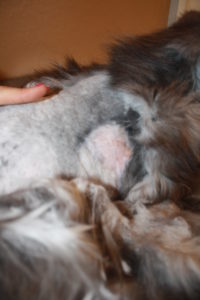
Save the licking to the cats. And save the grooming to the pros. It’s so much safer that way.
Here’s the deal….. you can save your cat’s life by having it groomed on a regular (i.e. 4-6 week) basis by an expert cat groomer (find a CFMG – they are the bestest!).
You can also save yourself some fat vet bills and visit to the ER.
And then, once kitty is freed from imprisonment by its own hair, you can do your part by visiting the expert cat groomer every 4-6 weeks so your precious little princess furball foo foo is treated like a precious little princess furball foo foo. A groomed cat is a happy cat! I promise. And it’s just so totally that easy.
I leave you with this to wrap up Part 3 of The Grossness Series.
From my salon – The Wall of Shame.
Some of these works of art had to be aired out a bit before they could hang on the wall. They were rank. Bleh! Formerly worn by real, living cats that walked around in someone’s house…..through the kitchen (where people eat and store food)….. on the bed (where people lay their heads at night)……… with the children (who touch everything)……..
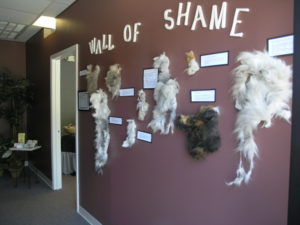
Need some help getting clients off the neglect cycle and onto a regular maintenance groom schedule?
See the full Grossness series of articles:
Part 1 – The Gross Side of Cat Grooming
Part 2 – Cats Groom Themselves?

